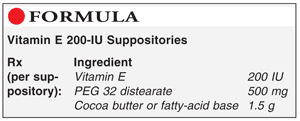US Pharm. 2009;34(9):56-57.

Method of Preparation: It may be necessary to adjust the amount of cocoa butter or fatty-acid base depending upon the mold being used. Calculate the quantity of each ingredient for the amount to be prepared. Accurately weigh or measure each ingredient. Gently heat the PEG 32 distearate; as it begins to melt, add the cocoa butter or fatty-acid base and lower the temperature while mixing. Incorporate the vitamin E; mix well. Pour the mixture into suppository molds; allow it to cool. Trim, package, and label.
Use: Vitamin E suppositories have been used to treat anal and rectal irritation and inflammation.
Packaging: Package in tight, light-resistant containers.
Labeling: Store in refrigerator. For rectal use. Use only as directed. Keep out of the reach of children.
Stability: A beyond-use date of up to 6 months can be used for these suppositories.1
Quality Control: Quality-control assessment can include weight, specific gravity, active drug assay, color, texture of surface, appearance, feel, melting test, dissolution test, physical observation, and physical stability.2
Discussion: Vitamin E is used in numerous topical products for the alleviation of minor skin irritations and disorders, ranging from cosmetics to pharmaceuticals. Vitamin E is a collective term applied to a large number of natural and synthetic compounds, the most important of which are the tocopherols. Alpha-tocopherols are the most active and widely distributed in nature. Alpha-tocopherols naturally occur as the optical isomeric d-form, which is more active than the synthetic racemic dl-form. It is practically odorless and tasteless. The alpha-tocopherols and alpha-tocopheryl acetates occur as clear, yellow, or greenish-yellow viscous oils. They are unstable to air and light, especially in an alkaline medium. The esters are stable to air and light, but unstable to alkali. Vitamin E is used to prevent oxidation of polyunsaturated fatty acids; it reacts with free radicals, which cause oxidative damage to cell membranes. Vitamin E deficiency is rare, but can develop when dietary intake is inadequate.3
PEG 32 distearate (CH3(CH2)16CO(OCH2CH2)nOCO(CH2
Cocoa butter (theobroma oil) is a yellowish or white-colored brittle solid with a slight odor of cocoa. It is derived from natural sources and is composed primarily of triglycerides of saturated and unsaturated fatty acids. It melts between 31˚C and 34˚C, is freely soluble in chloroform and ether, and is slightly soluble in 95% ethanol. Heating cocoa butter to a temperature greater than 36˚C results in a lowering of the solidification point owing to its polymorphic nature and the formation of a metastable form. It should be stored at temperatures less than 25˚C. A major ingredient in chocolate, cocoa butter also is used as a suppository base.6
Fattibase is a preblended suppository base that is used with a fatty-acid base, occurring as an opaque white solid. It contains triglycerides derived from palm, palm kernel, and coconut oils, with self-emulsifying glyceryl monostearate and polyoxyl stearate as emulsifying and suspending agents. It is stable, has a bland taste and odor, and has a controlled melting range. It is widely used as a replacement for cocoa butter in suppositories, lipsticks, and lip balms. It has a melting point between 35˚C and 37˚C, and its specific gravity is 0.890.7
Fatty-acid base (Hard Fat Suppository Base, Suppocire, Witepsol) consists primarily of mixtures of the triglyceride esters of the higher saturated fatty acids (C8H17COOH to C18H37COOH), along with varying proportions of mono- and diglycerides. Some types may also contain additives such as beeswax, lecithin, polysorbates, ethoxylated fatty alcohols, and ethoxylated partial fatty glycerides. The substance occurs as a white or almost white, practically odorless, waxy, brittle mass. When heated to 50˚C, it melts to a colorless or slightly yellowish liquid. It is slightly soluble in warm ethanol and practically insoluble in water. It should be stored, protected from light, in an airtight container at a temperature at least 5˚C below its melting point. Suppositories made from this base should be refrigerated.8
REFERENCES
1. US Pharmacopeial Convention, Inc. USP Pharmacists' Pharmacopeia. 2nd ed. Rockville, MD: US Pharmacopeial Convention, Inc; 2005:775-779.
2. Allen LV Jr. Standard operating procedure for performing physical quality assessment of suppositories, troches, lollipops and sticks. IJPC. 1999;3:56-57.
3. Sweetman SC, ed. Martindale: The Complete Drug Reference. 35th ed. London, England: Pharmaceutical Press; 2007:1828-1830.
4. Ash M, Ash I. Handbook of Pharmaceutical Additives. 3rd ed. Endicott, NY: Synapse Information Resources Inc; 2007:803.
5. Shur J. Polyoxyethylene stearates. In: Rowe RC, Sheskey PJ, Quinn ME, eds. Handbook of Pharmaceutical Excipients. 6th ed. London, England: Pharmaceutical Press; 2009:554-556.
6. Reilly WJ Jr. Pharmaceutical necessities. In: Gennaro AR, ed. Remington: The Science and Practice of Pharmacy. 19th ed. Easton, PA: Mack Publishing Co; 1995:1409.
7. Fattibase product information. Minneapolis, MN: Paddock Laboratories, Inc; 1989.
8. Moreton RC. Suppository bases, hard fat. In: Rowe RC, Sheskey PJ, Quinn ME, eds. Handbook of Pharmaceutical Excipients. 6th ed. London, England: Pharmaceutical Press; 2009:722-726.





